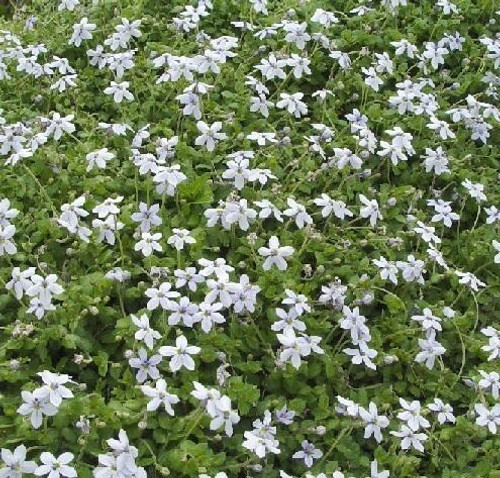Product Description
Laurentia fluviatilis, Lobelia fluviatilis or Isotoma fluviatiliss 'Blue Star Creeper' Ten (10) plants
Common Name: Laurentia, Swamp Isotome.
Zone (5) 6 to 10.
Full sun, with some afternoon shade in southern zones.
1 to 2 inches high groundcover.
Small, light blue, star-shaped flowers bloom from late spring to early summer. Spreading semi-evergreen groundcover mat of round, green leaves.
Blue Star Creeper likes organic, moist, well-drained soil. Mulch around, not on top of plants. Water well the first year. Water weekly during summer droughts or plant in a moist location. Grows to about 1 to 2 inches high mat of round, green leaves, with about 1 foot spread the first year.
Place in rock, woodland and fern gardens, between steppingstones, or with bulbs and lilies. Tolerates foot traffic.
This is a charming little plant that has gone through some name changes over the years. Here is what you should know:
Current Name and Synonyms:
- Accepted Scientific Name: Lobelia pedunculata
- Synonyms: Lobelia fluviatilis, Isotoma fluviatilis, Pratia pedunculata
Why the Confusion?
Plant taxonomy is an ever-evolving field. As scientists conduct more research and analyze genetic relationships, plant names and classifications sometimes change. This plant has been shuffled around a bit, hence the multiple scientific names.
Key Features of Lobelia pedunculata:
- Growth Habit: A low-growing, mat-forming perennial that spreads via creeping stems.
- Flowers: Produces masses of small, star-shaped flowers in shades of blue-violet. Blooms for an extended period, usually from spring to fall.
- Foliage: Small, rounded, green leaves that form a dense carpet.
- Hardiness: Generally hardy in USDA zones 6-9.
- Uses: Excellent ground cover, ideal for rock gardens, between paving stones, or cascading over walls.
Ten (10) plants in 4.5-inch containers per flat (or tray).
Other Details
The most important part of the plant is its root system. Healthy roots are the foundation of a healthy, vibrant plant. The type of plug container used is based on the specific needs of the plants. Perennials offered as bare root traditionally perform better when planted as bare root.Planted in a specialized mix, potted plants have well established root systems. Top growth stage will vary depending on the current life cycle and time of year when shipped. In Winter and early Spring dormant plants may be shipped. Dormant plants may be planted right away, even before the last frost date.
Most bare root varieties are field grown for at least one season, though Hemerocallis and Hosta are grown for two seasons. The bulk of the soil is removed during the harvesting process and the tops of most varieties are trimmed back to the crown. They are graded, packed in shredded aspen or sphagnum moss and stored in freezers until ready to be shipped.
See our Container Sizes and Bare Root Perennials pages for more information.
Plant information and care is provided in the Overview section, Plant Genus Page and general information is provided in the Planting Care & Guides. Additional questions can be asked on each Plant page.
Plant Spacing: Using the maximum mature spread or width of a plant to guide spacing, ensures space to grow to full size. To fill an area sooner, plant them closer together. Just remember, future thinning or transplanting may be needed.
Water: Keep a close eye on newly planted perennials, especially throughout the first growing year. Most early plant loss is due to too much or too little water!
















